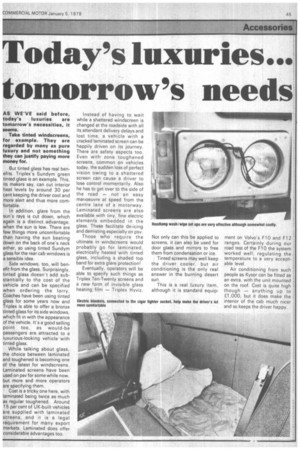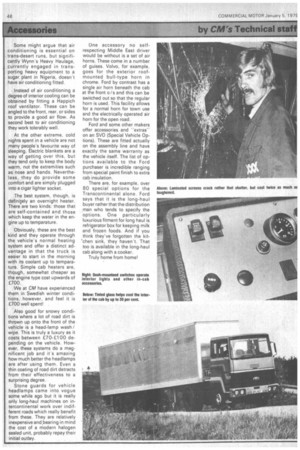Today's luxuries.'
Page 47

Page 48

If you've noticed an error in this article please click here to report it so we can fix it.
tomorrow's needs
But tinted glass has real benefits. Triplex's Sundym green tinted glass is an example. This, its makers say, can cut interior heat levels by around 30 per cent keeping the driver cool and more alert and thus more comfortable.
ln addition, glare from the sun's rays is cut down, which again is a distinct advantage, when the sun is low. There are few things more uncomfortable than having the sun beating down on the back of one's neck either, so using tinted Sundym glass for the rear cab windows is a sensible idea.
Side windows, too, will benefit from the glass. Surprisingly, tinted glass doesn't add substantially to the cost of the vehicle and can be specified when ordering the lorry. Coaches have been using tinted glass for some years now and Triplex is able to offer a bronze tinted glass for its side windows, which fit in with the appearance of the vehicle. It's a good selling point too, as would-be passengers are attracted to a luxurious-looking vehicle with tinted glass.
While talking about glass, the choice between laminated and toughened is becoming one of the latest for windscreens. Laminated screens have been used on psv for some while now, but more and more operators are specifying them, Cost is a tricky one here, with laminated being twice as much as regular toughened. Around 15 per cent of UK-built vehicles are supplied with laminated screens, and it is a legal requirement for many export markets. Laminated does offer considerable advantages too. Instead of having to wait while a shattered windscreen is changed at the roadside with all its attendant delivery delays and lost time, a vehicle with a cracked laminated screen can be happily driven on its journey. There are safety aspects too. Even with zone toughened screens, common on vehicles today, the sudden loss of perfect vision owing to a shattered screen can cause a driver to lose control momentarily. Also he has to get over to the side of the road — not an easy manoeuvre at speed from the centre lane of a motorway. Laminated screens are also available with tiny, fine electric elements embedded in the glass. These facilitate de-icing and demisting especially on psv.
Those who require the ultimate in windscreens would probably go for laminated, electrically heated with tinted glass, including a shaded top band for extra glare protection!
Eventually, operators will be able to specify such things as Triplex Ten-Twenty screens and a new form of invisible glass heating film — Triplex Hyviz. Not only can this be applied to screens, it can also be used for door glass and mirrors to free them from condensation or ice.
Tinted screens may well keep the driver cooler, but air conditioning is the only real answer in the burning desert sun This is a real luxury item, although it is standard equip ment on Volvo's F10 and F 1 2 ranges. Certainly during our road test of the F10 the system worked well, regulating the temperature to a very acceptable level.
Air conditioning from such people as Kysor can be fitted as an extra, with the unit mounted on the roof. Cost is quite high though — anything up to . £1,000, but it does make the • interior of the cab much nicer and so keeps the driver happy. Some might argue that air conditioning is essential on trans-desert runs, but significantly Wynn's Heavy Haulage, currently engaged in transporting heavy equipment to a sugar plant in Nigeria, doesn't have air conditioning fitted.
Instead of air conditioning a degree of interior cooling can be obtained by fitting a Happich roof ventilator. These can be angled to the front, rear, or sides to provide a good air flow. As second best to air conditioning they work tolerably well.
At the other extreme, cold nights spent in a vehicle are not many people's favourite way of sleeping. Electric blankets are a way of getting over this, but they tend only to keep the body warm, not the extremities such as nose and hands. Nevertheless, they do provide some comfort and are simply plugged into a cigar lighter socket.
The best system, though, is definitely an overnight heater. There are two kinds: those that are self-contained and those which keep the water in the engine up to temperature.
Obviously, these are the best kind and they operate through the vehicle's normal heating system and offer a distinct advantage in that the truck is easier to start in the morning with its coolant up to temperature. Simple cab heaters are, though, somewhat cheaper as the engine type cost upwards of £700.
We at C/l/i have experienced them in Swedish winter conditions, however, and feel it is £700 well spent! .
Also good for snowy conditions where a lot of road dirt is thrown up onto the front of the vehicle is a head-lamp wash / wipe. This is truly a luxury as it costs between £70-El 00 depending on the vehicle. However, these systems do a magnificent job and it's amazing how much better the headlamps are after using them. Even a thin coating of road dirt detracts from their effectiveness to a surprising degree.
Stone guards for vehicle headlamps came into vogue some while ago but it is really only long-haul machines on intercontinental work over indifferent roads which really benefit from these. They are relatively inexpensive and bearing in mind the cost of a modern halogen sealed unit, probably repay their initial outlay. One accessory no selfrespecting Middle East driver would be without is a set of air horns. These come in a number of guises. Volvo, for example, goes for the exterior roofmounted bull-type horn in chrome. Ford by contrast has a single air horn beneath the cab at the front o/s and this can be switched out so that the regular horn is used. This facility allows for a normal horn for town use and the electrically operated air horn for the open road.
Ford and some other makers offer accessories and "'extras" on an SVO {Special Vehicle Options). These are fitted actually on the assembly line and have exactly the same warranty as the vehicle itself. The list of options available to the Ford purchaser is incredible ranging from special paint finish to extra cab insulation.
There are, for example, over 80 special options for the Transcontinental alone. Ford says that it is the long-haul buyer rather that the distribution man who tends to specify the options. One particularly luxurious fitment for long haul is refrigerator box for keeping milk and frozen foods. And if you think they've forgotten the kit'chen sink, they haven't. That too is available in the long-haul cab along with a cooker.
Truly home from home!




















































































